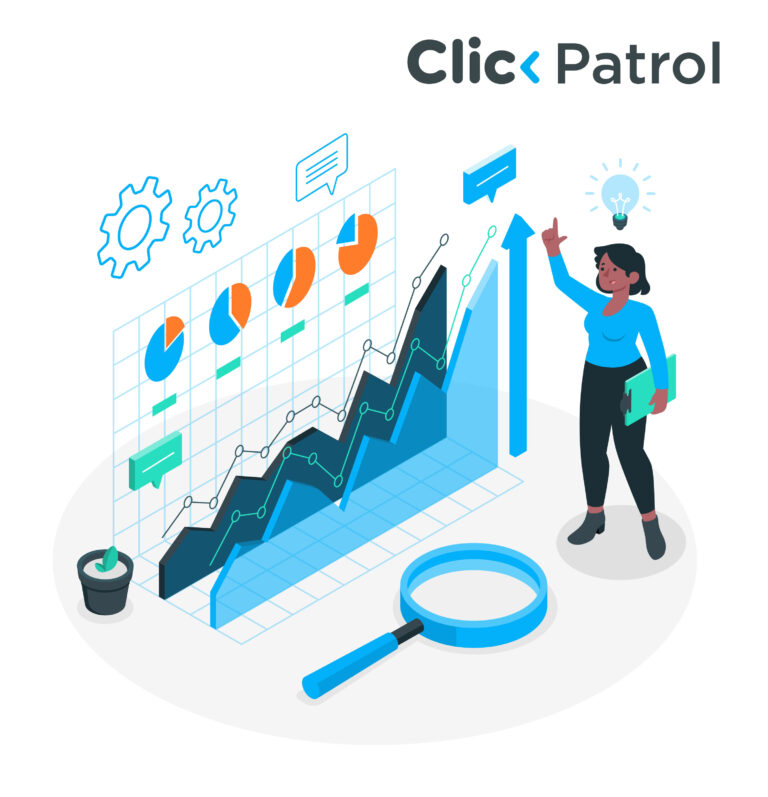
Impact of Click Bots on PPC Marketing
Abisola Tanzako | Jun 20, 2024

Table of Contents
- What are click bots?
- The difference between good and bad click bots
- How do click bots work?
- The impact of click bots on marketing campaigns
- 1. Depleting marketing budgets
- 2. Uneven data and analytics
- 3. Deteriorating campaign performance
- 4. Increased cost-per-click (CPC)
- 5. Damaging brand image
- 6. Effect on competitor campaigns
- 7. Impacting ad network connections
- Strategies to avoid click bots
- 1. Setup IP exclusions
- 2. Schedule ads
- 3. Consider remarketing campaigns
- 4. Consistently check traffic patterns.
- 5. Modify the target location
- 6. Use CAPTCHA for the landing page
- 7. Update ad strategies frequently
- 8. Use bot detection software
- Lower Your Risk of Click Bots
- FAQs
Do click bots impact your PPC campaigns?
Consider this: You have just started a brand-new, intriguing advertising campaign for your company. You have devoted a significant amount of your marketing budget to this to increase website traffic and profit. But after a few days, you notice something strange. Your website’s stats indicate a sharp visitor increase, yet sales are still flat.
What might be the reason for this difference? Click bots!
Click bots are malicious software created to mimic human clicks and manipulate statistics about website traffic. This article will explore the world of clickbots and ways of safeguarding your company against their evil actions.
What are click bots?
Click bots are automated software applications that mimic human clicks on websites. They can be configured to carry out particular actions, such as completing forms, clicking links or ads, and adding items to shopping carts. Click bots are used for various purposes. On one end of the spectrum, they are respectable participants in several online activities. However, they are notorious for being employed in fraudulent and manipulative practices, sometimes called “click fraud.”
The difference between good and bad click bots
Click bots can be used for malicious or beneficial reasons. Let’s see how the two differ from one another:
Good click bots
Well-designed click bots are typically used for positive and helpful objectives. For example, search engines such as Google use these bots to index and crawl web pages, which is necessary to produce relevant search results. They improve user experience by assisting with tasks like automatically checking web pages, ensuring links function correctly, and ensuring website design works in various browsers and devices.
Good bots follow website guidelines and conventions, such as observing the directives in the robots.txt file, which specify how bots interact with website content.
Bad click bots
Click bots with malicious intent are employed in damaging and deceitful ways. This involves click fraud in online advertising, whereby individuals create fictitious clicks on pay-per-click advertisements, squandering advertising funds and distorting campaign data. These bots can also be employed in competitor click fraud, which involves using up a competitor’s advertising budget by making phony clicks. They can also distort user behavior analytics, resulting in poor business decisions.
In contrast to good bots, bad click bots tend to ignore website protocols and engage in aggressive crawling and interaction with web content, potentially leading to server overloads or privacy violations. It is essential for online businesses and digital advertising to comprehend the nature of click bots and distinguish between their dangerous and useful applications.
How do click bots work?
Click bots mimic a human user’s clicks on digital elements, including banner adverts, PPC ads, and web links. These bots are made to resemble humans in a variety of complex ways. It’s important to investigate their fundamental mechanisms and the technologies that make it possible to understand their work thoroughly. This is a simple breakdown of how they function:
- Automated clicks: A click bot is a computer program that visits websites on autopilot and clicks on advertisements. It repeatedly performs this action.
- Copying human behavior: Astute click bots can mimic human behavior. They click on ads nonstop, wander around, take breaks, and act unpredictably, making it difficult to spot them.
- Working in teams: Click bots can operate alone and in large groups. When they work together in a group (known as a botnet), they can be found on numerous computers across the globe, clicking on ads to give the impression that many different persons are clicking.
- Remaining hidden: The intelligent click-bots attempt to avoid detection. They can even disguise their location by altering their clicking habits and posing as people from different places.
- Why they click: These automated clickers typically have two motivations: either they click on advertisements on websites to generate revenue, or they click on them to waste another person’s ad spend without any genuine interest in the advertised goods.
Simply put, click bots are automated web robots that click on advertisements. They might be basic or sophisticated, work alone or in teams, and their primary responsibility is to click on ads for various purposes. This frequently results in issues for the businesses that are sponsoring the ads.
The impact of click bots on marketing campaigns
Click bots can have a big, often negative, impact on advertising operations. Here are some ways they might impact the field of digital advertising:
1. Depleting marketing budgets
The most obvious impact of click bots on advertising campaigns is ad budget wastage. The advertiser pays for each click a bot makes on a pay-per-click (PPC) ad, but unlike a genuine potential consumer, a bot never completes a transaction. This lowers the ad campaign’s overall return on investment (ROI) because the money invested in these clicks is wasted.
2. Uneven data and analytics
Click bots distort the data advertisers use to gauge the effectiveness of their ads. Excessive numbers of fraudulent clicks distort engagement and click-through rates (CTRs), providing an inaccurate impression of ad performance. As a result of this incorrect data, advertisers may target the wrong audience or increase their investment in underperforming ads.
3. Deteriorating campaign performance
A high volume of bot traffic can considerably lower campaign conversion rates because bots do not generate sales or leads. This impacts the campaign’s performance and makes it difficult to determine which components truly connect with actual users.
4. Increased cost-per-click (CPC)
Increased click activity can raise the cost-per-click for bidding-based PPC networks like Google Ads. Not only are bots wasting your money by clicking on your advertising, but they may also increase the cost of future ad placements.
5. Damaging brand image
If a sizable amount of the traffic resulting from your campaign is false, your brand’s reputation may be impacted. Genuine consumers can easily find your content in an artificially inflated traffic landscape. If they do, the impression of a lack of real-world involvement might damage your brand’s credibility.
6. Effect on competitor campaigns
Unfair competition may result from competitor click fraud, which uses bots to target an opponent’s advertisements. This unethical behavior may result in higher advertising expenses and budget waste for the impacted competitors.
7. Impacting ad network connections
Advertisement networks may become frustrated with persistent click fraud. If a substantial portion of the traffic is fraudulent, ad networks may flag an advertiser’s content, leading to account scrutiny or suspension.
Strategies to avoid click bots
Advertisers can further reduce their risk by taking a few proactive measures, even though advertising platforms such as Google have processes to detect and combat click bots. When implemented correctly, PPC can be a game-changer for businesses in the B2B industry. Here are some practical ways to consider as an addition:
1. Setup IP exclusions
You can prevent specific IP addresses from viewing your ads if you find that they are consistently causing suspicious clicks. Most ad networks help you keep potential scammers from engaging with your ads by allowing you to block particular IP addresses.
2. Schedule ads
Adapt your ad schedules to run when the people in your target demographic are most active and actual engagement is more likely. This can lessen the exposure to click bots, which frequently function when users aren’t typically browsing.
3. Consider remarketing campaigns
Remarketing efforts focus on those who have already visited your website and expressed interest in your good or service. This method lowers the possibility of fraudulent clicks by concentrating ad expenses on more qualified, previously engaged users.
4. Consistently check traffic patterns.
Pay particular attention to your campaign’s data. Click bots can be detected by abrupt spikes in traffic inconsistent with increases in conversions, unusually high click-through rates, or an influx of traffic from irrelevant places.
5. Modify the target location
Consider excluding such regions from your campaigns if you see fraudulent activity coming from particular regions. On the other hand, you can concentrate more on areas where you know your genuine audience is present.
6. Use CAPTCHA for the landing page
Adding CAPTCHA verification to your landing pages can discourage bots. CAPTCHAs function as a barrier to stop automated clicking programs from performing the required activity on your website since they need activities that bots usually can’t reproduce.
7. Update ad strategies frequently
You can be one step ahead of fraudsters by upgrading your ad campaigns regularly and staying current on the newest developments in click fraud. This entails experimenting with various ad formats, broadening the range of ad networks you use, and continuously improving your targeting specifications.
8. Use bot detection software
To effectively get rid of click bots, bot detection software such as ClickPatrol is non-negotiable. These solutions make it easier to spot possible click fraud and take appropriate action by providing sophisticated monitoring features and automatically flagging questionable activity. ClickPatrol’s superior algorithm blocks bots before they even click on your ads. We have a database of bot IPs that are automatically blocked once a user signs up. We’ll also screen every click on your ads and block fraudulent ones.
Lower Your Risk of Click Bots
By implementing the methods mentioned above and employing third-party tools to detect and block fake clicks, you may greatly lower your risk of being a victim of a click bot. Watchful and proactive measures are essential to safeguard your ad spend and guarantee the legitimacy of your digital marketing initiatives. Remain vigilant, stay educated, and keep your advertising tactics flexible to tackle the ever-changing problem of click bots.
FAQs
Q.1 Do bots always cause click fraud?
No, bots are not invariably the source of click fraud. Although click bots are a frequent source, individuals can commit fraud, especially when using click farms. Click farms use human clickers to click on advertisements, links, or web pages to produce phony clicks and traffic. This human-driven type of click fraud complements the automated method bots employ.
Q.2 Are bots clicking links?
Yes, Bots do click links. Click bots are computer programs designed to mimic human clicks on different kinds of links, such as those found in emails, advertisements, and online sites. Their main objective is to imitate human communication to manipulate engagement metrics or engage in illicit activities such as virus distribution or ad fraud.





